Soybean looper, Chrysodeixis includens (Walker) (Lepidoptera: Noctuidae) (Figure 1), is a major economic pest in Florida, with an extensive host range spanning a broad range of agronomic, vegetable, and floriculture crops, including peanut and cotton (Specht et al. 2015). A survey conducted in the United States in 2021 indicated that soybean looper is a key pest and major concern in soybean production in southeastern states, including Florida (Huseth et al. 2021). This pest is also detected in peanut, causing economic damage and yield loss (Boernel et al. 1992). Pest management has been predominantly insecticide use (Musser et al. 2020), with reports of field-evolved resistance to diamide (Catchot et al. 2016). The increased concerns with this pest demand accurate scouting, which should be triggered as soon as the initial flight of soybean looper moths is detected in the fields. This publication provides essential identification and pheromone trapping data pertaining to this key pest species. The target audience includes agronomic and vegetable growers, extension agents, crop consultants, state and local agencies, researchers, and interested Florida citizens.
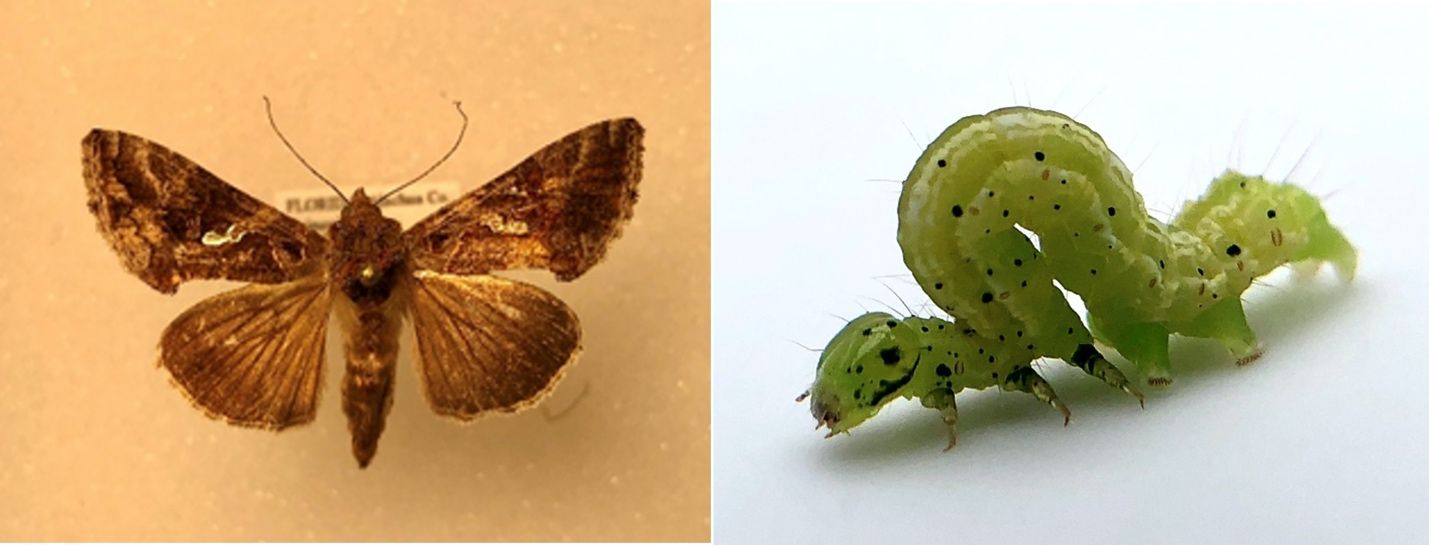
Credit: Tyler Shaw, UF/IFAS
One of the components of integrated pest management (IPM) for this pest is the trapping of soybean looper moths to monitor and record their flight patterns. The traps used (Figure 2) are baited with soybean looper female sex pheromones. The pheromone trap acts as an early warning system, allowing agricultural professionals to detect the presence of soybean looper moths in the region, and before egg deposition and subsequent larval populations start causing economic damage in the host crops. However, the commercial formulations of soybean looper pheromones are non-specific (Meagher 2001), and the lack of specificity results in the cross-attraction of closely related species. These species appear very similar to soybean looper and may be misidentified as soybean looper, resulting in an overestimation of soybean looper populations and unnecessary or improperly timed insecticide applications.
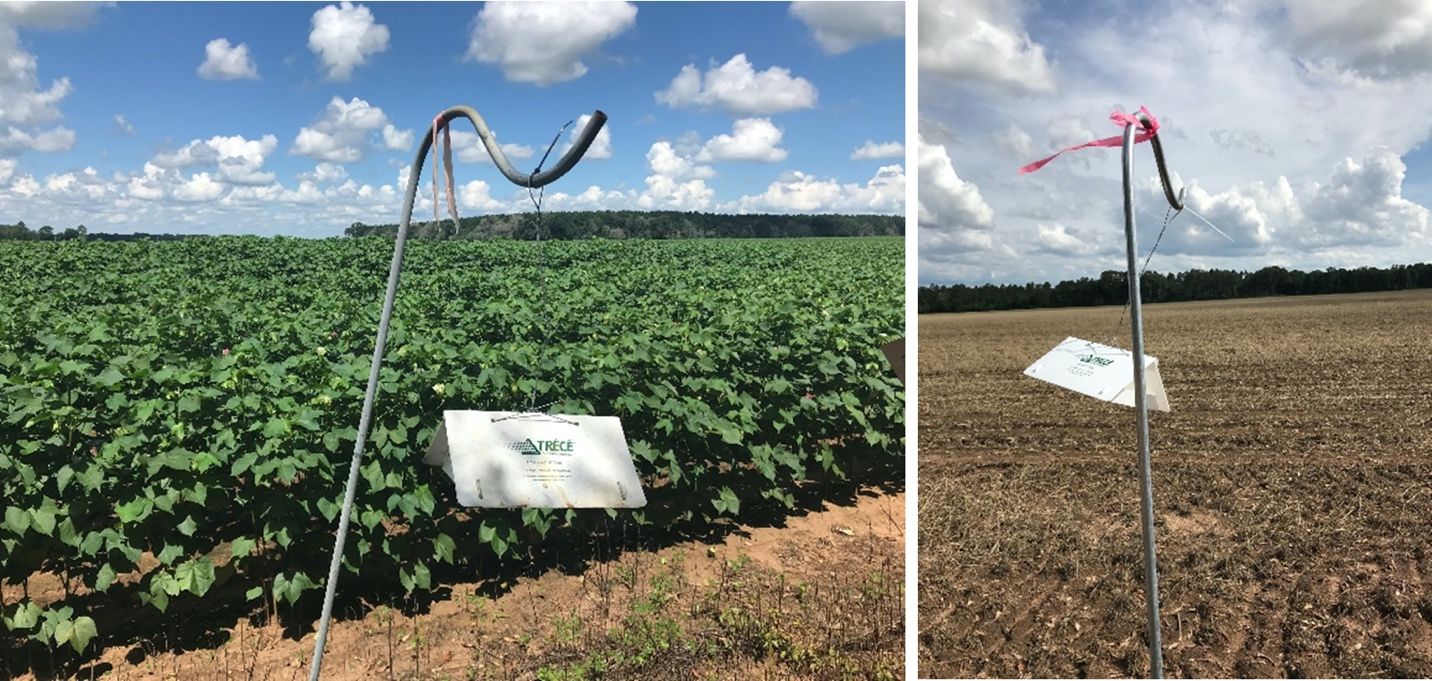
Credit: Silvana Paula-Moraes, UF/IFAS
In addition to the soybean looper, at least four other species in the family Noctuidae are cross-attracted to the soybean looper female sex pheromone lures in the region of the Florida Panhandle. These include the sharp stigma looper (Ctenoplusia oxygramma), golden looper (Argyrogramma verruca), cabbage looper (Trichoplusia ni), and gray looper moth (Rachiplusia ou). The most concerning of these four cross-attracted moths is the sharp stigma looper (Figure 3) due to its high seasonal abundance and a seasonal flight pattern similar to that of the soybean looper (Figure 4) (Shaw et al. 2020).
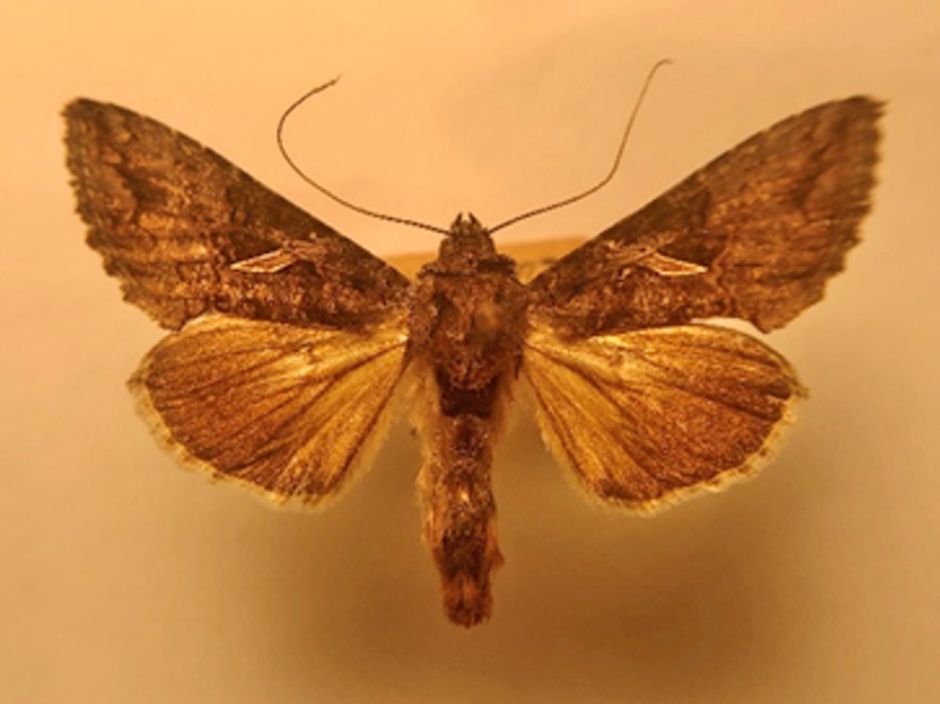
Credit: Tyler Shaw, UF/IFAS
The sharp stigma looper is not classified as a pest of peanut or cotton, and its abundance could greatly skew estimated population numbers of soybean loopers. Though the occurrence of both species is similar throughout the year, some differences in the timing of flight of these two species should be considered. Soybean loopers have the greatest average population levels from July through October. In the summer months of May through July, the sharp stigma looper is trapped at its highest numbers while soybean looper numbers are relatively low in May and June. In July, the number of trapped soybean loopers begins to exceed the number of sharp stigma loopers. In August, the number of trapped soybean loopers is at its highest, far exceeding the number of trapped sharp stigma loopers. Soybean looper then remains the dominant moth trapped through the end of the year. While soybean looper numbers greatly decrease in November, this species remains the most trapped species through December, though numbers of trapped soybean loopers and sharp stigma loopers are comparable in December (Shaw et al. 2020) (Figure 4). Thus, because of the high abundance of the sharp stigma looper in May and June, the timing of insecticide applications to manage soybean looper may be earlier than necessary if proper identification is not made.
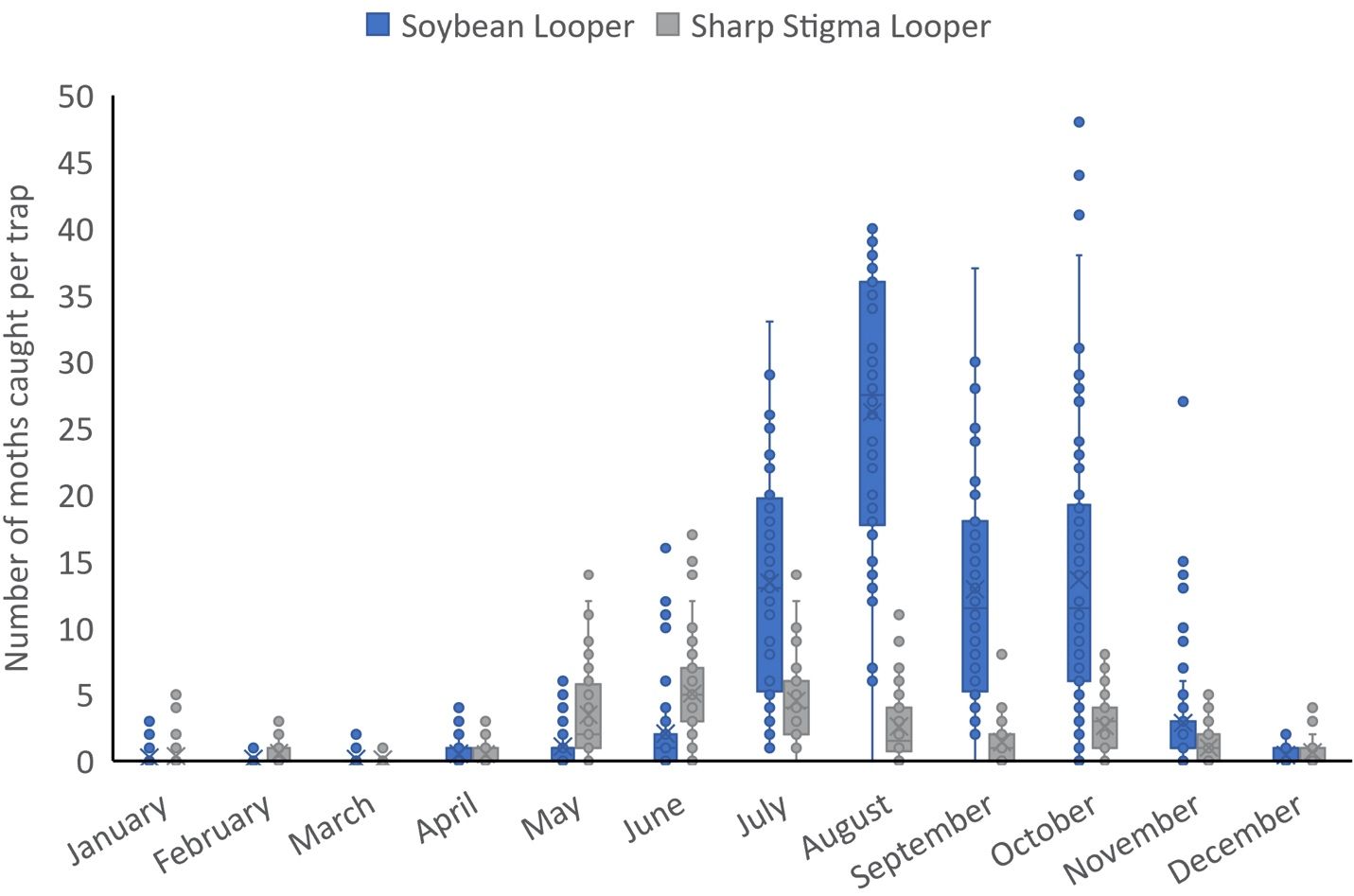
Credit: Tyler Shaw, UF/IFAS
Because cross-attracted species appear very similar, one of the most definitive ways to properly identify these species is by observing the obvious differences in their wing patterns (Figure 5, 6). The most apparent difference between the two species and the easiest way to distinguish between them is in the distinct silvery markings on their forewings. Both species have silvery markings in the same area, but the sharp stigma moth’s markings assume the distinct knife or blade-like shape from which the species gets the name sharp stigma. The soybean looper, by contrast, has silvery spots in the same location, but they are not knife-shaped (Poole and Lafontaine 1991) (Figure 5). This characteristic wing pattern of the sharp stigma looper allows for easy differentiation from the soybean looper, making it relatively simpler for agricultural professionals to discern the two species when compared to other cross-attracted species. These markings are easily discernable to the naked eye. However, a hand lens with 5x to 10x magnification is recommended for more reliable identifications, especially in cases in which the moths have lost wing scales (Figure 6).
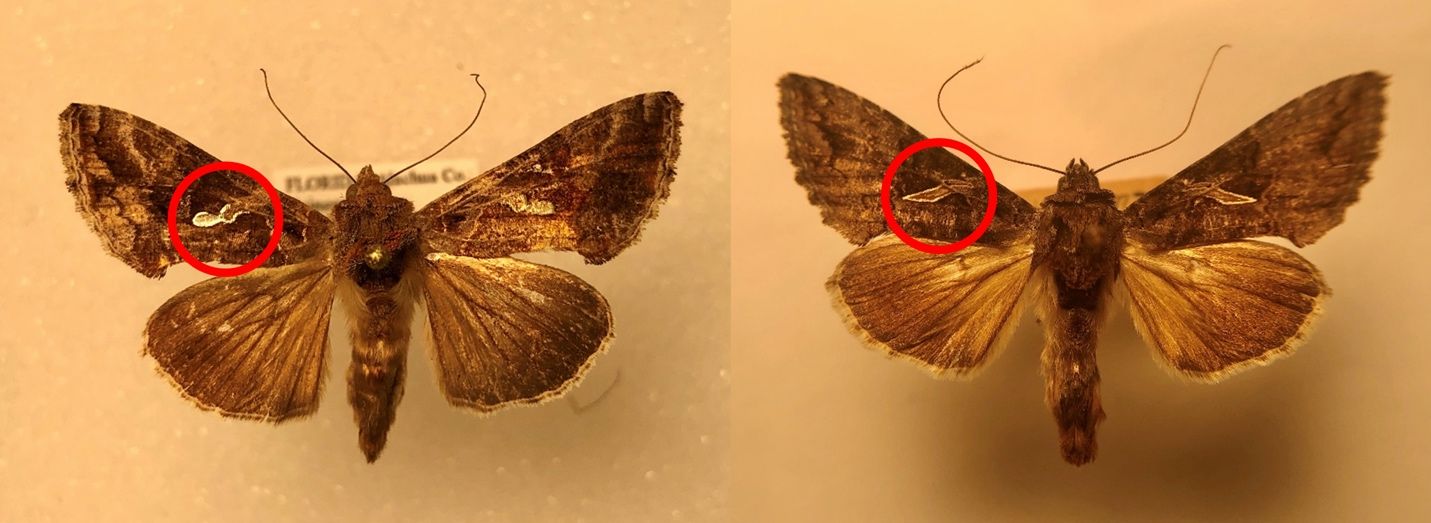
Credit: Tyler Shaw, UF/IFAS
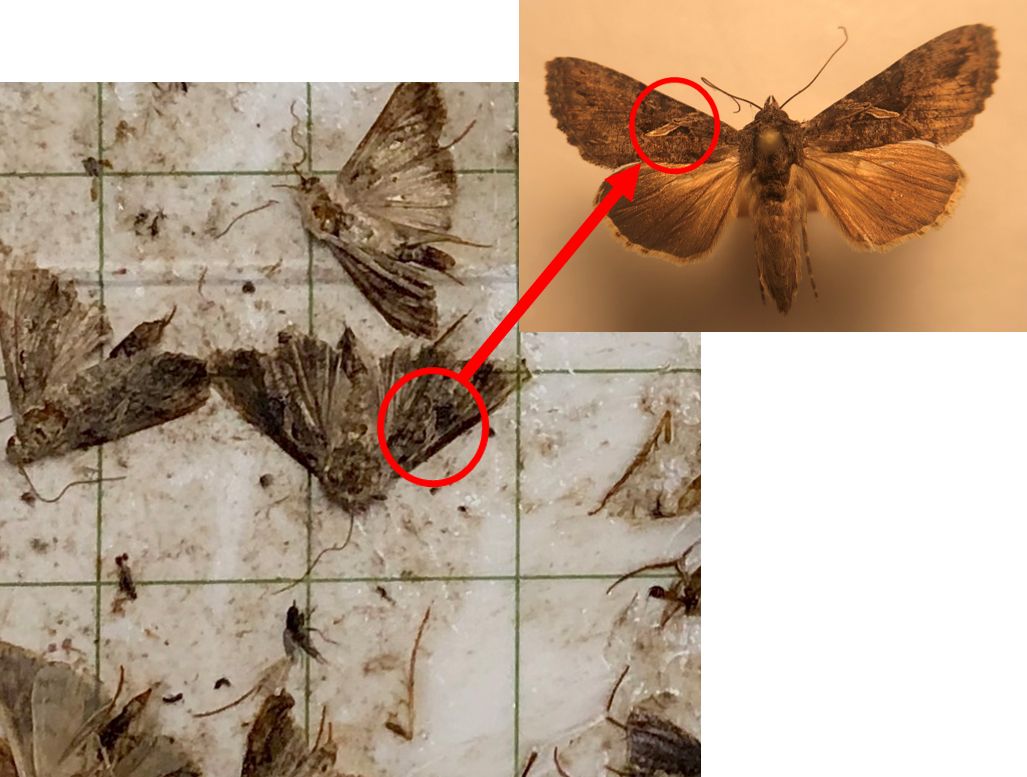
Credit: Tyler Shaw, UF/IFAS
Though pheromone trapping is not specific to the species of concern, the soybean looper, identifying sharp stigma loopers in traps can result in more accurate estimations of moth populations occurring in the agricultural landscape. Consequently, if necessary, properly timed insecticide applications may be made, thus making pheromone trapping an essential part of an IPM framework and avoiding preventive insecticide sprays without occurrence of the pest.
References
Huseth, A. S., R. L. Koch, D. Reisig, J. A. Davis, S. V. Paula-Moraes, and E. W. Hodgson. 2021. “Current Distribution and Population Persistence of Five Lepidopteran Pests in U.S. Soybean.” Journal of Integrated Pest Management 12. doi: 10.1093/jipm/pmab004.
Boernel, D.J, J. S. Mink, A. T. Wier, J. D. Thomas, B. R. Leonard, and F. Gallardo. 1992. “Management of Insecticide Resistant Soybean Loopers (Pseudoplusia Includens) in the Southern United States.” Pest Management of Soybean. 321 https://doi.org/10.1007/978-94-011-2870-4_7
Meagher, R .L. 2001. “Collection of Soybean Looper and Other Noctuids in Phenylacetaldehyde-Baited Field Traps.” Florida Entomologist 84:154.
Poole, R. W., and J. D. Lafontaine. 1991. “Noctuoidea: Noctuidae (part): Plusiinae.” The Wedge Entomological Research Foundation, Washington, D.C.
Specht, A., S. V. D. Paula-Moraes, and D. R. Sosa-Gómez. 2015. “Host plants of Chrysodeixis includens (Walker) (Lepidoptera, Noctuidae, Plusiinae).” Revista Brasileira de Entomologia. 59:343–345.
Shaw, T. J. 2020. Annual Meeting of the Entomological Society of America. In Seasonal Flight Patterns of Chrysodeixis Includens (Lepidoptera: Noctuidae) in the Florida Panhandle and Inventory of Plusiine Species Cross-Attracted to Pheromone Traps. Entomological Society of America, Lanham, MD.